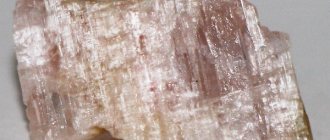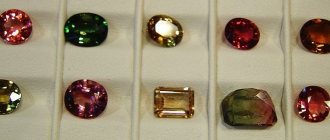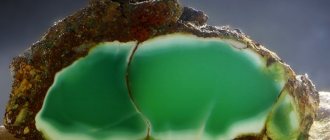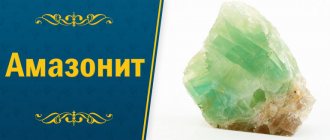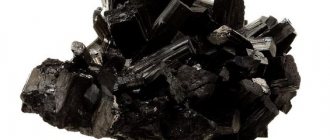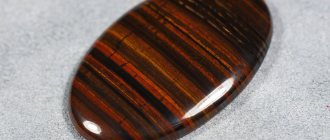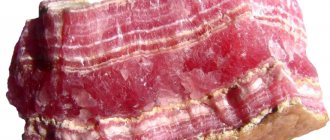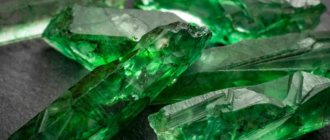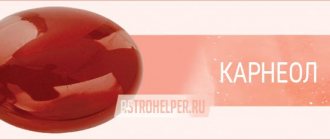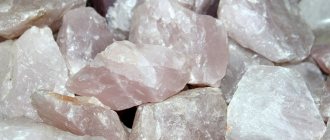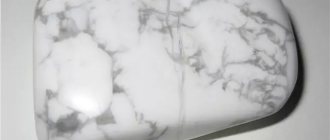| Category | Tourmaline |
| Title in English | Paraiba |
| Formula | XY3Al6(OHF)4[BO3]3[Si6O18] |
| Group | Tourmaline group |
| Color | Light Blue, Greenish Blue, Blue, Purple Blue |
| Stroke color | Grayish white |
| Shine | Glass |
| Transparency | Transparent, Translucent |
| singonia | Trigonal |
| Hardness | 7 — 7,5 |
| Cleavage | Absent |
| Density, g/cm³ | 3,06 |
| Kink | Conchoidal |
| origin of name | The first deposits of stone were discovered in 1988 in Brazil in the state of Paraiba, from which the name was derived. |
Place of Birth
Until recently, the only known deposits for Paraiba were mines located in Brazil. It was discovered there in the late 80s of the last century during the development of old pegmatite deposits. That is, in fact, Paraiba is an ancient stone, although it was not known to man.
— Advertising —
Today, Paraiba deposits are also being developed in Mozambique and on the island of Madagascar. Many miners from Brazil take the stone from these places to their homeland in order to later sell it as expensive Brazilian Paraiba.
History of the stone
Pioneer discovery
The discovery of the Paraiba gem belongs to Heitor Dimas Barbosa, who zealously searched in the state of Paraiba in Brazil for new minerals hitherto unknown to mankind. Its development lasted for more than five years, which, in the end, was crowned with unprecedented success: deposits of intergrowths of cylindrical plates, a variety of tourmaline, were discovered. These precious stones were distinguished by the richness of their color, as well as their characteristic ability to polarize light and refract it. The gem glowed like neon, letting light pass through it.
Heitor Dimos himself never saw the discovery of his mines, since he died shortly before. The deposit of the found gem was for a long time considered the only one on the planet. The name of the stone was given in honor of the Brazilian state where it was discovered.
Finding a second deposit
— Advertising —
At the beginning of the new millennium, a new deposit of Paraiba was found in Nigeria. These samples contained slightly less copper, but were no different in appearance from their Brazilian counterparts. Scientists explain the fact of finding identical gems on different continents by the fact that in ancient times they were all part of a single continent.
History and origin of the mineral
In 1788, the scientist A.G. Werner described the main properties of the gem and became the author of its unusual name. He called the stone "deceiver" in Greek because of its tendency to imitate other precious minerals. But the gem gained fame much later.
In 1920, during an expedition headed by the scientist Fersman, blocks of green crystals were accidentally discovered. It is paradoxical that the purpose of the expedition was phosphorus fertilizers, but minerals of the phosphate group were found.
Apatite belongs to a group of mineral formations in the earth's crust. In nature, it can be found in sedimentary and igneous rocks.
An interesting fact is that microcrystals of this substance are found even in the teeth and bones of living organisms.
Watch the video about the stone:
Physico-chemical characteristics
Paraiba is a tourmaline.
Its chemical composition includes ions of sodium, calcium, lithium, iron, magnesium, manganese, aluminum, gallium and vanadium. Paraiba crystals are anisotropic, have a trigonal system, glassy luster, and have no cleavage. Paraiba is painted in shades of blue, blue, violet and green in their combination.
Hardness on the Mohs scale is 7-7.5. Specific gravity 3.06 g/cm3. Refractive index 1.624-1.644. Birefringence: 0.018-0.040. Variance: 0.017
Varieties of apatite
The general group of apatites is divided into types according to the predominance of the main elements in the chemical formula of the mineral. The basis is a compound of phosphorus oxide with calcium (Ca10(PO4)6), and hydroxide, fluorine or chlorine can already be added to it:
- Hydroxyapatite , in which the hydroxyl group predominates. Forms aggregates of a dense structure of predominantly red and blue colors. It is this variety that underlies human bones and teeth.
- Fluorapatite , which contains about 4% fluorine. Found application in the production of fertilizers and filling material in dentistry.
- Chloropatite containing 7% chlorine has a pronounced glass luster.
- Carbonate type with a predominance of calcium.
- Strontium.
Magic properties
Paraiba has found use in many religious rituals as a cult stone, due to its ability to influence the higher spiritual spheres of life.
It is believed that it cleanses the owner’s aura and protects against negative external influences, the evil eye, damage, and bad people . Along with other tourmalines, Paraiba helps a person understand himself. This stone is considered masculine and brings health, courage, masculinity, and honesty. Paraiba crystal eliminates bad thoughts, stimulates daydreaming, spiritual search, and self-knowledge.
Greenish stones have a calming effect. Instances of blue color promote honesty, determination, self-control, and bestow faith in one’s own strength.
The maximum magical properties of paraiba are revealed in gold frames.
Stones masquerading as Paraiba tourmaline
Often, due to external similarities, many other precious and artificial stones are confused with Paraiba tourmaline, not to mention fraudulent activities when potential buyers are deliberately misled about the uniqueness of the gem being sold.
The category of gemstones very similar to neon tourmaline includes:
- Paraiba apatite crystal , meaning "to deceive" in Greek. It is often confused with Paraiba tourmaline due to its similarity in color.
- Paraiba quartz has a color similarity to the legendary tourmaline , and this is easily explained: its main chemical component, like the mineral from Brazil, is copper.
- Neon tourmaline is often confused with blue topaz . However, Paraiba topaz has a completely different chemical composition, and its deep color and shine are achieved by special laser processing.
View this post on Instagram
Publication from Stylish Jewelry (@indigoshop.ru) June 20, 2022 at 8:57 PDT
Sitall
Sitall is an artificial stone used to imitate various gems. Thanks to the latest technologies, the quality of jewelry glass has reached a very high level.
It is difficult to distinguish artificial stone from natural tourmaline in terms of color saturation and other parameters, such as strength, in which Paraiba sital is in no way inferior to the natural mineral. The best examples of artificial stones are made in the USA, Hong Kong and South Korea.
Medicinal properties
The stronger the neon glow of the stone, the more powerful its healing properties are considered.
In general, Paraiba organizes the thoughts of its owner, has a positive effect on the state of the central nervous system, eliminates nervousness, anxiety, depressive states, and improves the psycho-emotional background. In addition, Paraiba has a stimulating effect on the immune system, gives a person strength and energy, but at the same time gives peace, stability and balance.
With the help of Paraiba, you can achieve healthy, sound sleep, get rid of nightmares and fears. The stone improves appetite and normalizes metabolism.
Applications
In jewelry, the incredibly beautiful and unique Paraiba is incredibly popular. Its ability to polarize light increases when the stone is cut, which it lends itself well to due to its high hardness. Paraiba is used as inserts in a wide variety of jewelry and is classified as an expensive precious stone.
Colors
Paraiba tourmaline is distinguished by its bright, rich blue-turquoise color, which is no longer found in nature.
Once cut, even in low light, the mineral specimen exhibits a beautiful play of color, giving it a neon or electric appearance. The natural color of Paraiba can be artificially enhanced by annealing. After this procedure, the crystals become very rich and bright. So, blue and green Paraibas are very popular. But natural specimens of purple and red color, which contain an admixture of manganese, are discolored using heat treatment.
Description
Apatite is widely distributed in nature. The ions of manganese, aluminum, chlorine, iron, and strontium attached to phosphate and calcium explain the variety of shades of the gem and varying degrees of transparency.
The main color range of the mineral is green with a bluish tint . There are yellow, brown, pink and even red stones.
Interesting! Some colors have their own name. For example, the yellow variety is called asparagus, and blue apatite is called moroxite.
Artificial gem
Almost all natural Paraiba specimens are heat treated to enhance color.
Thus, samples from Africa are painted in purple, pinkish, green, and yellowish-green tones. After heating, they acquire the desired blue-green hue without any pink or purple impurities. Brazilian samples are always blue, but can be light, and then they are also treated with high temperatures.
To make the stone appear cleaner and free from defects, cracks in it are now often filled with polymer materials. All of these manipulations reduce the cost of natural stone, and the manufacturer must report this.
How to distinguish from a fake
Despite the fact that Paraiba tourmaline was discovered relatively recently, they have already learned how to skillfully falsify it. Silicon ingots are treated with various chemical elements by exposing them to pressure and high temperatures: potassium, aluminum, bromine, etc.
View this post on Instagram
Posted by Precious Gemstones (@pureje_) May 22, 2022 at 7:20 am PDT
To distinguish a natural gem from a fake, it is recommended to pay attention to the following features:
- It is very difficult for natural stone to cause any damage.
- When examining the edges of a gem from different angles, its color organically changes.
- The crystal has magnetic powers: if you hold it in your hand, and then bring a small sheet of paper to the mineral, it will immediately be attracted to the stone.
How to care for stone
It is recommended to wear paraiba jewelry mainly in the evening.
This is due to the fact that direct sunlight has a bad effect on the quality of the stone. With prolonged exposure to the sun, the gem fades and loses its color and optical properties. The best frames for it are gold and platinum. Store Paraiba tourmaline in tightly closed boxes, wrapped in soft cloth, separately from other types of stones. Use cool running water to clean products.
Decorations
Every piece of jewelry with Paraiba tourmaline is doomed to success. World-famous jewelry houses such as Dior, Tiffany, Spark Creations, etc. know this and actively use it. Jewelry with a famous gem looks great framed in yellow or white gold and in combination with diamonds, as well as colorful precious stones, such as sapphires or emeralds.
Paraiba and zodiac sign
Paraiba goes best with zodiac signs such as Pisces, Cancer and Scorpio.
The stone also has a positive effect on Libra and Aquarius. Paraiba is not recommended for Virgo and Capricorn. The gem does not come into direct conflict with all other signs of the zodiac, but it will not be able to provide significant assistance to them.
Horoscope compatibility
Beautiful Brazilian and African stones are perfect for Pisces, Scorpios and Cancers. Astrologers also noticed a certain beneficial effect on representatives of the zodiac sign Libra and Aquarius. How does Paraiba affect:
- Cancers often suffer from excessive impressionability and shock. Jewelry with a variety of tourmaline will help you to steadfastly overcome emotional outbursts.
- Scorpios are not always able to keep their passions under control. For calmness and restraint, astrologers recommend that representatives of this sign have a Paraiba talisman with them.
- Pisces are highly susceptible to fantasies and dreams. A talisman in the form of a beautiful turquoise crystal will help them stay in reality.
- Representatives of the earth element, Taurus, Virgo and Capricorn love to work, they are real workaholics. The tourmaline talisman will relieve fatigue and take care of your health.
- For Aquarius, Libra and Gemini, the crystal will help them find inspiration and enhance their creative abilities.
- Representatives of the fire element, Aries, Sagittarius and Leo, are quite emotional. A bluish mineral with a glow will support and sometimes restrain the internal fire.
Product prices
From the beginning of its use in jewelry, Paraiba has always been very popular. Due to its rarity and beauty, prices for this stone continue to rise all the time. For example, today the average cost of 1 carat of Brazilian Paraiba is $1,000 - $10,000.
Early mentions
There is an opinion that the production of the first glass ceramic samples dates back to 1739. At that time, the French naturalist and academician, René Antoine Reaumur, actively carried out experimental activities in order to obtain glass that was resistant to high temperatures.
The result of the academician’s efforts was a mineral that resembles porcelain in its physical and chemical properties. At the same time, the sital stone had a milky tint and practically did not transmit light, due to the many small crystals formed inside the solid glass body. Reaumur considered his creation meaningless, and the glassware was lost in the darkness of centuries, until the 20th century.
Interesting Facts
- The first example of Paraiba stone was demonstrated in Arizona in 1990. The gem was initially valued at a couple of hundred dollars per carat, but literally within a few days the price for it rose to $2,000 per carat due to high demand.
- The largest of the first Paraiba found was immediately sold for $2,000, and was recently resold for $25,000.
Price
There is only one Paraiba tourmaline per 10 thousand diamonds, and it is extremely rare that it turns out to be more than one carat. This explains the corresponding cost of Paraiba. Since the discovery of blue crystal for the jewelry industry, its market price has risen by 70% and today averages between $1,000 and $10,000 per carat.
Sometimes cracks and irregularities in gems are filled with various polymer compounds to improve their characteristics. This circumstance significantly reduces the cost of such specimens. When purchasing precious Paraiba stones, it is recommended to take into account the records in the expert report, indicating their refinement.
Interesting! When the Paraiba gem was first exhibited at the 1989 gem show in Tucson, it was valued at just a few hundred dollars. Incredibly, in 4 days the price of blue tourmaline rose to $2000 US per carat. It is also known that the largest representative of Paraiba tourmalines in 1989 was purchased for $2,000 US and was recently resold to a new owner for $25,000 US per carat.
